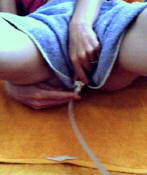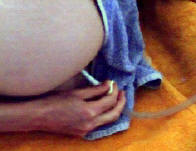Techniques on how to administer an enema
 The introduction of liquids by way of the rectum (enema) can be unpleasant and dangerous if not done properly and with care. The colon has no taste, cold, heat, burning or nerve sensation. It only responds to stretching such as gas pains or liquid filling it. It has much less defence from the invasion of microbes and parasites. This is why it is of utmost importance to gain knowledge about the colon and its functions first and to go slowly and be gentle at all times with your body.
The introduction of liquids by way of the rectum (enema) can be unpleasant and dangerous if not done properly and with care. The colon has no taste, cold, heat, burning or nerve sensation. It only responds to stretching such as gas pains or liquid filling it. It has much less defence from the invasion of microbes and parasites. This is why it is of utmost importance to gain knowledge about the colon and its functions first and to go slowly and be gentle at all times with your body.
Enema Technique
Lay a towel on the floor for comfort . Keep a small blanket or towel handy in case of chills. Use a folded towel or small pillow for your head. Weigh yourself before and after cleansing. Relax and focus on the healing that cleansing will provide.
Positions
There are many positions in which an enema can be taken.
Lying on the back is a favourite position, especially for the first enema of a session. This way you have a feeling of more control and it is easier to adjust the little tap for the water flow. You can watch the bag slowly deflate and you can also watch the abdomen expand as the water enters the colon. You will probably be most comfortable if the knees are raised. You will first see the belly swell very low, just above the crotch, as the sigmoid expands. Then you will see the left side start to bulge as the water enters the descending colon. You will be in a position to massage the bowel as well as feel the shape and position of your colon.
Two of the most widely known are the "Sims" position and the "Knee-Chest" position.
The Sims position has the recipient lying on the left side with the right knee brought up near the chest.
In this position it is not easy to turn the little tap on and off to regulate the water flow
It is good if you have someone to help you in this position.
The Knee-chest position has the enema supported by the knees and the shoulders with the chest sagging down so that the chest almost touches the floor (get on all four, put your head down and your bottom up). This places the abdomen nearly upside down so that the water can flow down from the rectum to the transverse colon by gravity. In cases of deep-seated constipation this position will help the water reach way up into the colon for a good cleaning out. It is also useful in a technique for floating air or gas in the colon above the water so that the air can be expelled.
Some people like to move in different positions during the enema eg: 1/3 on your left hand side, 1/3 on your back, and 1/3 on your right hand side.
Most people will find it difficult to retain an enema for more than 5 minutes. The enema should generally be retained between 15 and 45 minutes. It is better to hold less water (500ml) for longer than large amounts of water (1-2ltr) for a short time. Especially if you use some herbal solutions for the Enema.
Wind/Gas/Bloating
Gas in the digestive tract is created by: swallowing air, the breakdown of certain foods by bacteria that are present in the colon. Everyone has gas. It may be uncomfortable and embarrassing, but it is not life-threatening.
Air is eliminated by burping or passing it through the rectum. Most people produce about 0.5 to 1.5 litre a day and pass farts about 14 times a day. Most gas is made up of odourless vapours - carbon dioxide, oxygen, nitrogen, hydrogen, and sometimes methane. Things that contain sulphur often produce the unpleasant odour of flatulence.
What causes this in the digestive tract? In the digestive tract it comes from two sources: aerophagia (air swallowing) - usually caused by eating or drinking rapidly, as well as by chewing gum, smoking, or wearing loose dentures. Breakdown of certain undigested foods by harmless bacteria naturally present in the large intestine (colon).
Some carbohydrates (sugar, starches, and fibre) are not digested or absorbed in the small intestine because of a shortage or absence of certain enzymes. The undigested or unabsorbed food then passes into the large intestine, where harmless and normal bacteria break down the food. This process produces hydrogen, carbon dioxide, and, in about one-third of all people, methane gas, which is then released through the rectum.
If the bowel is not clean then the peristaltic action of the colon will push against the faecal masses and produce intense pressure. This will frequently happen with your first enema in a series. If there is substantial gas in the colon it may be very difficult for the colon to lift water when large air bubbles are present. These like to collect at the hepatic flexure high on the right side and can be detected by a rumbling sound when you press there.
If you want to get the gas out you can sit on the floor and make sure the gas is at the hepatic. Roll slowly onto the right side then massage the transverse following its course with your hands. You will know that you are moving that gas by the rumbling. When you have the gas moved to the splenic flexure move quickly to the knee-chest position. Now massage the descending colon from the ribs to the groin on the left side until the gas has moved to the sigmoid. Use heavy massage in the groin area to move water out of the sigmoid and move the gas in. When this is done get on the toilet quickly and you should be able to expel the gas. You may have to repeat this procedure several times.
Massage / Reflexology techniques
One reflex area is extremely helpful in colon problems. The whole outside of the thigh (right and left) should be rubbed vigorously daily for two weeks. Also the soles of the feet should be massaged. When you find particularly tender areas spend a little extra time on those.
Massage the lower abdomen gently counter clockwise while the solution is flowing in, and clockwise when the solution is flowing out. Generally start at the cecum and go up the ascending colon, across the transverse, and down the descending colon. This can help loosen hardened faecal material.
Don't be afraid to massage deeply, but don't force areas where there is great pain. Keep massaging these areas gently and regularly and the pain will disappear in due time.
On the Toilet
Don't sit on the toilet for more than a few minutes if there is no water coming out. Sitting too long and straining are the chief causes of haemorrhoids. Those will certainly ruin your enema pleasure. If nothing is coming out lie down either face down or up or lie on your left side or get into the knee-chest position. These will help the water move.
Most people in primitive countries do not have toilets, they squat.
Squatting straightens out the tube and allows proper contraction of the muscles that assists in eliminating. Not only will it reduce your chances of colon cancer, but you will eliminate much more without the kinks in the tube.
How can you squat on a commode? You can't practically, but you can imitate the same relative positioning and muscle tension as squatting.
If you have phone books, you can use those. You will need two sets of phone books that are eight to ten inches high. Any type of books will work. Two small boxes will work or anything where you can SECURELY place both feet while sitting on the toilet that is eight to 10 inches high.
Place the phone books (or whatever) on the floor where you normally place your feet while sitting on the toilet. Sit on the toilet. Place your feet on the phone books. Make sure the books are steady. Bend your head forward to where your head is over your knees and place about 1/3 of your weight on your feet.
If you do not have any phone books available or if you have to use someone else's rest room, there is again a simple but effective way to imitate the correct squatting position. When sitting on the toilet, do two things:
1. Bend your head forward and down to the position where your head is between your knees. Your back should be as close to parallel to the floor as possible. Your shoulders should touch your knees. Grab your legs between your ankle and knee. Grab your left leg with your left hand and your right leg with your right hand.
2. Pull your shoulders down against your knees.
By bending forward and placing your head between your knees you effectively straighten the tube out. By pulling your shoulders down you cause muscles to contract that aid in elimination.
You will feel the difference this position makes. You may notice that up to TWICE AS MUCH comes out this way. Not only does more come out, it comes out faster and easier. You should ALWAYS eliminate like this. NEVER eliminate sitting straight up on a toilet.
You will always eliminate faster, with less strain and you will eliminate more in this correct position. This is the next best thing to squatting.
When your colon is clean, you feel better and have less chance of all diseases. Squatting helps to keep your colon clean.
